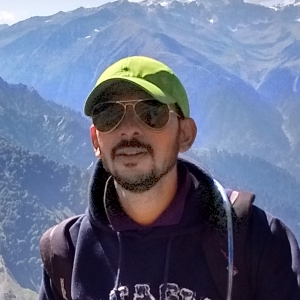
By Kaushal Oza
Travel Writer20 Nov 2017 - 8 Minute Read
“France has its lavender fields. Netherlands, its tulips. Sarajevo has roses,” an affable tourist guide announces in a thick Bosnian accent as I amble across Ferhadija, the old town’s main thoroughfare.
I break my stride. I don’t want to eavesdrop but it is hard not to stop for a second and look around.
Roses?
I see none.
The guide’s declaration about the city’s apparently abundant flora has confused his group of Japanese tourists as well. They nod politely but without conviction.
“If you don’t believe me just look there.” The young guide points to the ground in front of the Sacred Heart Cathedral.
I follow the inquisitive gaze of the Japanese tourists. At one place the cobblestoned harmony of the street is jarred by a huge cavity. Unevenly shaped holes petal out around it, all of them filled up with resin and colored red to create the semblance of a rose. Even in the name of modern art, the Sarajevo Rose appears to me like a rude intruder in an aesthetically restored street.
I continue walking, thankful that the so-called rose is on the ground and easy to miss.
My next stop, though similarly located at ground level, is hard to miss. It's a sign on the Ferhadija that boldly states “Sarajevo Meeting of Cultures.” It is at this spot, the sign proclaims, that the East meets West.
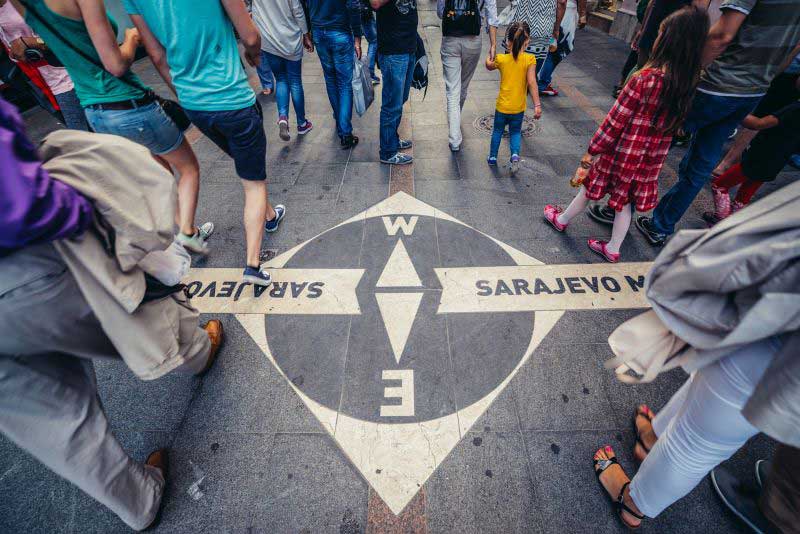
It sounds pompous, until I turn around to face the street I just walked. The opulent Baroque facade of the Austro-Hungarian buildings on the Ferhadija and the neo-Gothic bell towers of the Sacred Heart Cathedral dominate my view. Then I turn to face in the other direction and in a dramatic shift, minarets of mosques and the shapely domes of the Ottoman-era buildings crowd the eye line.
To add to this cultural confluence, a smaller lane leads to an old Jewish Synagogue dating back to 1581 and used by the Sephardic Jews. I now recall the many tourist agencies trying to sell Sarajevo as the European Jerusalem. They were not off the mark at all.
I linger on this spot, taking in the striking contrasts on offer, before the air becomes thick with the smell of freshly roasted coffee. I am instantly seduced and follow the compelling aroma through the Gazi Husrev Beg’s Bezistan, a domed shopping complex that condenses all the charm of Istanbul’s grand bazaar in an animated 109-meter shopping street. Soon I am in the narrow lanes of the Baščaršija, the Ottoman part of the old town.
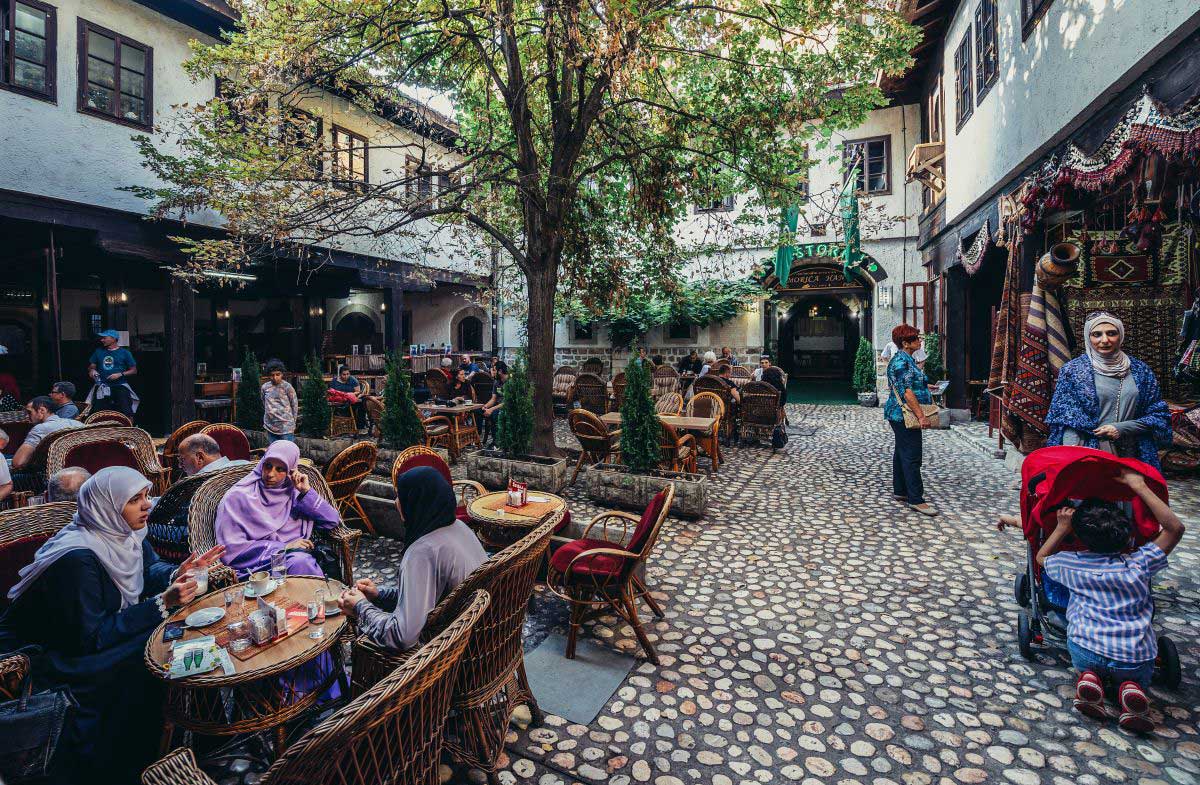
In the coffee houses here the miniature cups of Julius Meinel espresso have made way for the džezva, the copper coffee pot that holds the much more potent local brew. Since it is served with a lokum and is similar in appearance, I make the mistake of calling it Turkish coffee, causing the local customers to raise their dusty eyebrows.
The waiter, used to travelers unfamiliar with the difference, patiently explains to me that while Turkish coffee is made by boiling the water, coffee, and sugar together, Bosnian coffee is crafted by boiling the water first, adding the coffee to the boiling water to release its full flavor, and then boiling the mix again. This full-bodied brew is then capped by the thick, velvety foam that is the pride of any self-respecting brewer.
“One Bosnaska kahva then?” I ask the waiter tentatively, rather than order.
“Or simply say naša kahva,” an elderly gentleman sitting next to me chimes in, peering over his Sarajevo Times. I hesitate, but he gestures encouragingly.
“Naša kahva, please,” I say. The waiter smiles and disappears into the kitchen.
“Naša kahva - Our coffee.” The old man pats me on the back. “Now you’re one of us.”
My new friend’s name is Emir Ademović and he has lived each of his 83 years in Sarajevo. Over the next couple of hours, he regales me with tales of the city and anecdotes about the local culture. I mention the Sarajevo Rose and wonder if the locals, too, consider it an eyesore.
“Ah, the Sarajevske ruže,” he exclaims. “Come with me.”
Emir and I are standing again at the entrance of the Cathedral.
“But this time, don’t look down. Look up,” Emir tells me.
I follow Emir’s cryptic advice.
“Do you see the hills? All around Sarajevo. Now it is 1992. The war has begun. The Serbs have stationed their artillery on the top of those hills… And now, for the next 1,425 days – for almost the next four years, that is – Sarajevo will be pulverized with an average of more than 300 bombshells from those hills. One out of those many hundred thousand shells exploded right here, in front of the church. Killing someone. After the war, these craters left by the bombs were painted red as a silent prayer to the victims of the bombing. We call them Sarajevo Roses. ”
We walk back silently. Before parting, Emir tells me that Sarajevo endured the longest siege in the history of modern warfare. These roses are everywhere. “So you see,” he concludes, “France has its lavender fields. Netherlands, its tulips. Sarajevo has roses.”
Once you begin to notice them, the signs of war are all around. That evening I take a walk through Kazandžiluk where the pungent smell of vinegar mixes with the tickety-tick of coppersmith working away at their wares. At the end of the street I find a souvenir shop. It is curious that in a country that looks heart-shaped on the map, the souvenirs are all bullet-shaped. Bullet-shaped keychains, bullet-shaped pens, bullet-shaped flash lights. Some souvenir shops even claim that these are real bullets from the war.
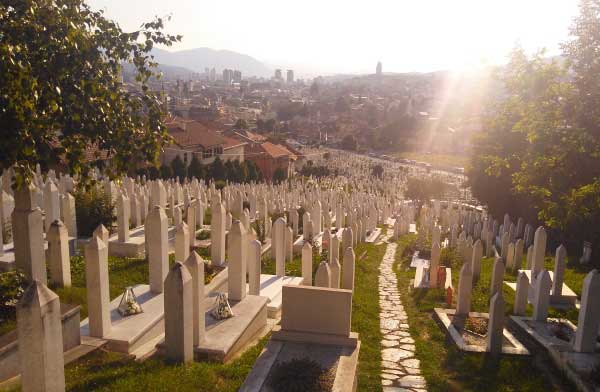
I cross the tramline and climb to the Yellow Fortress, an 18th century citadel with impressive views of the city. On the way, the land that was once a public park is now lined with over a thousand marble tombstones. All are from around the same time – the early 90’s. When I get to the top of the Yellow Fortress I can see each neighborhood of Sarajevo has a similar graveyard, only much bigger. I imagine that during the siege the enemy artillery would have been stationed at the Yellow Fortress, too. Maybe one of the guns would have been placed just where I am sta…
It is then that a cannon goes boom.
I freeze. The roar of the cannon fire echoes around me, shaking me to the core.
I clamber down the Yellow Fortress to find the streets of the old town abuzz with festivities. It is the holy month of Ramadan. The ćevapčići shops of Baščaršija are bustling with Sarajevans breaking their fast over plates of this succulent, kebab-like dish.
I am reassured. The only cannons that are fired in Sarajevo these days are the ones celebrating Iftar – the meal that breaks the holy fast. If you ever hear the cannons in Sarajevo, don’t be shocked. It is an invitation to join the celebrations.
As I try to score a seat for myself in one of the lively restaurants, I am reminded of Emir’s anecdote that best describes the Sarajevan spirit.
The Sarajevo Film Festival was conceived and first held while the city was under siege. At a time when people had no food, water, or electricity, some considered the film festival a luxury. At the opening ceremony, a journalist asked the Festival director why the festival during the war.
The Festival director stared back and simply asked, “Why the war during the festival?”
Discover similar stories in
connection
Travel Writer
Kaushal Oza is based in Mumbai, India and was a winner of the 2017 World Nomads Travel Writing Scholarship.
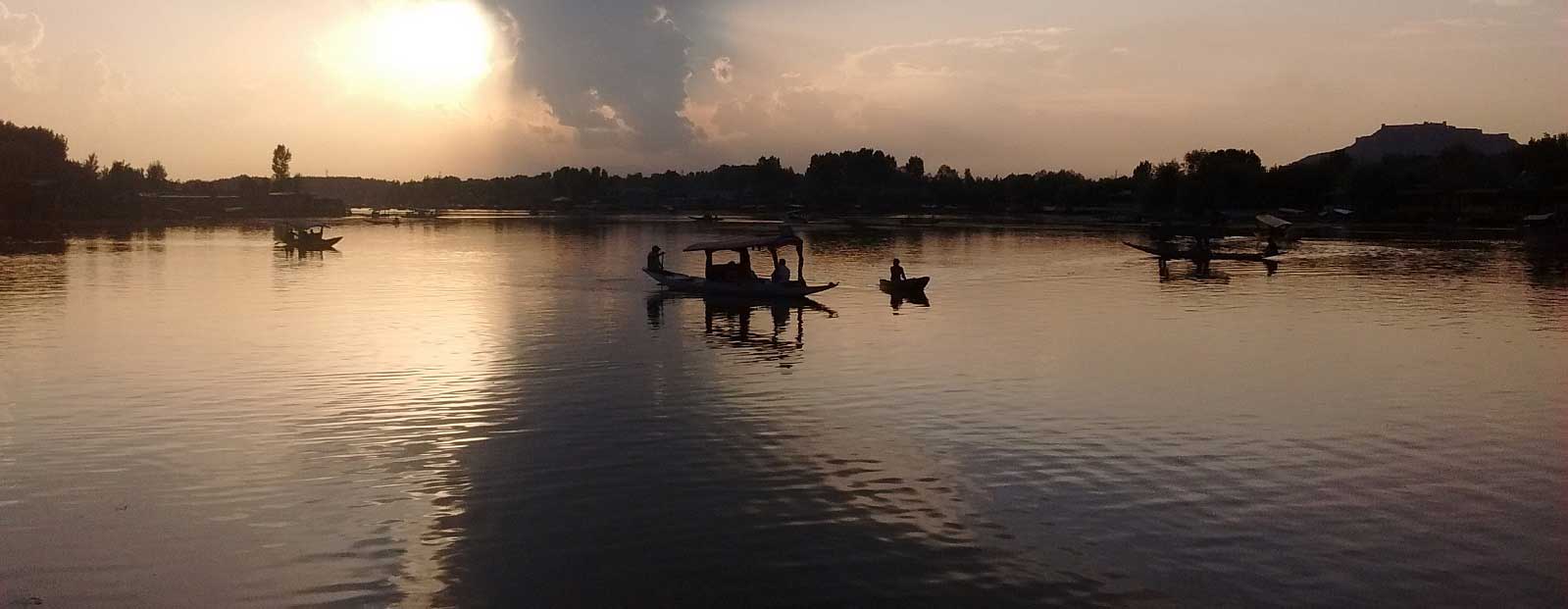
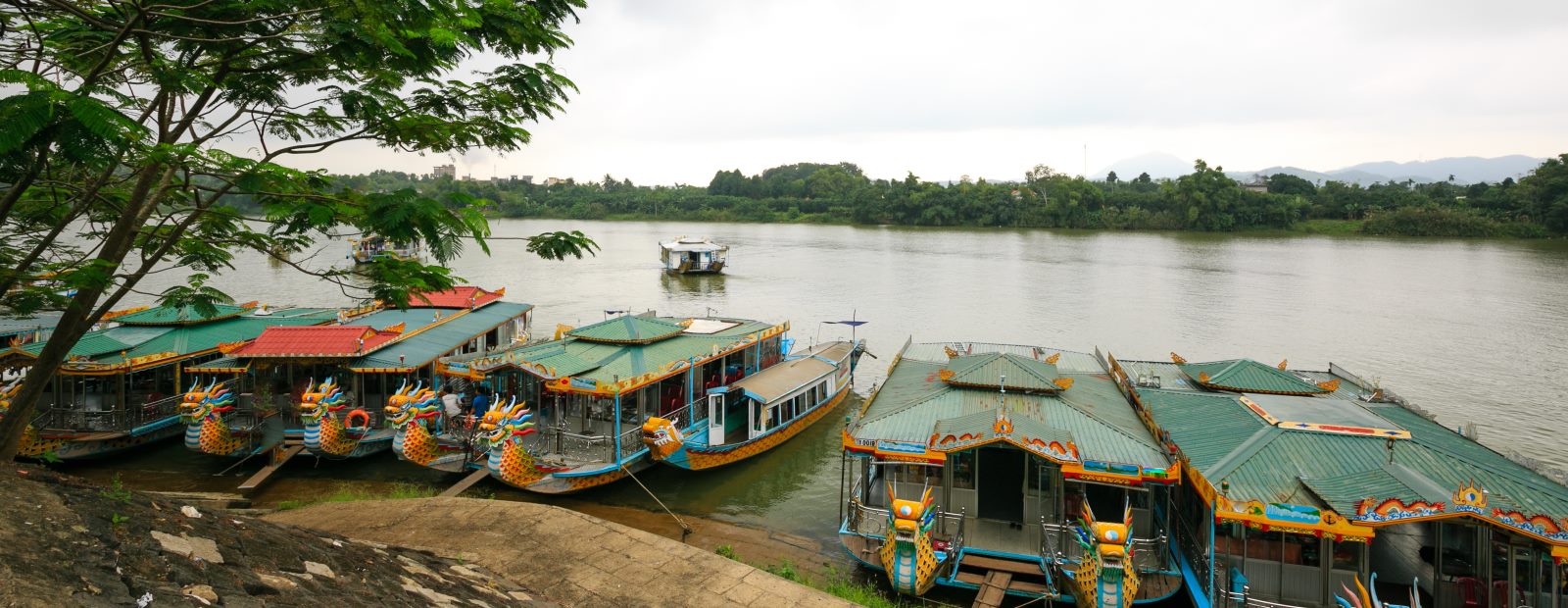


4 Comments
Beautiful piece. I was at Sarajevo just a few days ago and can feel its very soul through your descriptions!
Very beautiful and insightful peace. Glad you experienced such a wonderful historical encounter with Emir. Def on my bucket list!
Knowing you personally I began reading your article by not only being unbiased but by opening up all the faculties that judges and criticises best, but was too taken in by this writing. It is sensitive and beautifully expressed and truly gave my imagination those invisible wings that carried me to Sarajevo and be part of your experience.
Loved the way you added life to the mundane "Sarajevo roses" by translating it to "Sarajevske ruže". Nothing beats seeing a city through the eyes of the locals. I believe every city every village has its essence and you have encapsulated the essence of Sarajevo.